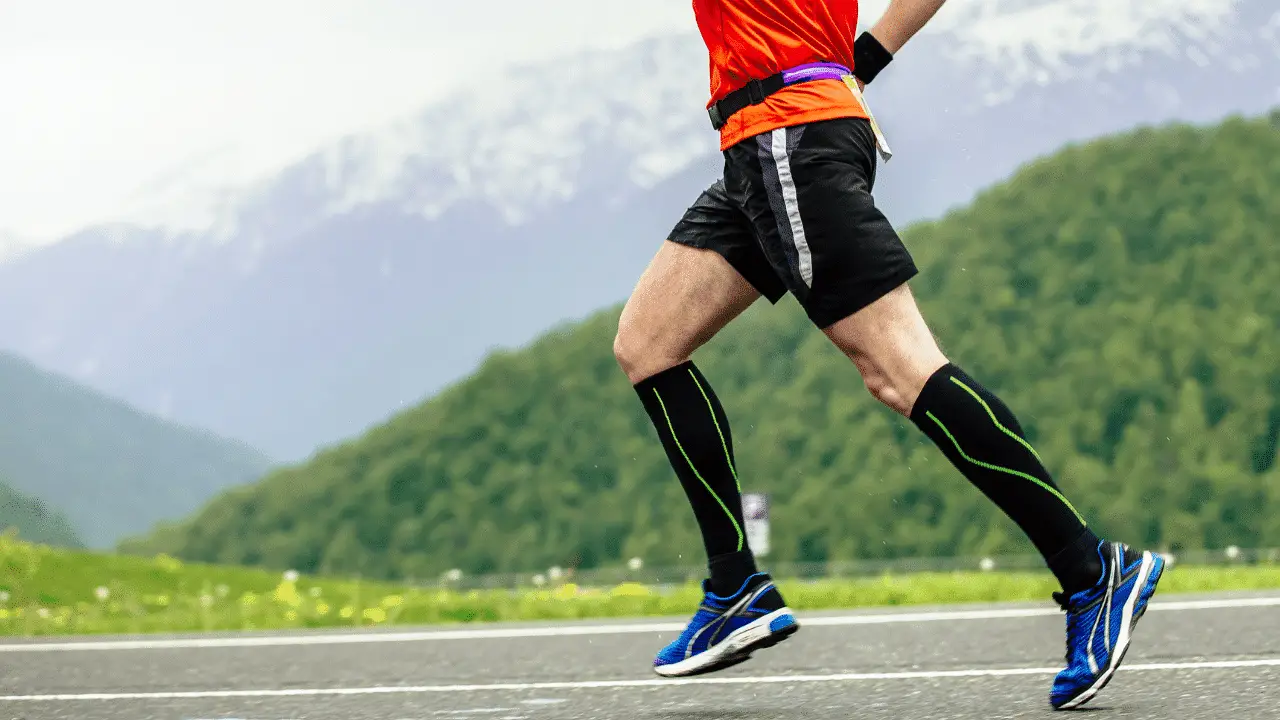Compression socks are a relatively new type of sportswear but are recommended by medical professionals for a range of different reasons.
In this article, I will explain what compression socks do for running.
Overall, compression socks increase recovery parameters from running by 6% if they are worn for 48 hours after running.
Studies have also shown that they provide a marginal but observable improvement in running endurance.
Compression socks have a unique measurement called compression. This is not to be confused with the compression of old running shoes! Below, I will cover the details of the findings of studies that showed the benefits of compression socks for running and some guidelines for what type of compression socks you should get.
What Are Running Compression Socks?
Before getting into more detail about the benefits of running compression socks, it’s a good idea to cover exactly what compression socks are and how they differ from other tight-fitting clothing like leggings. Here’s what running compression socks are.
Running compression socks are a sock that is much tighter than normal. It is worn on the foot, but is typically long and also covers the calf. Medical professionals state they allow for better blood flow up the legs and back to the heart. Ideally, they should have 20mm of compression.
Compression socks for running are made of a range of different materials. Common materials are nylon, polyester, lycra, spandex, cotton, and microfiber. There are a few different lengths, some are similar to stockings and cover the entire thigh. But, some go to just below the knee.
Compression running socks that go to just below the knee are more commonly worn for running. They are constructed so that they are narrower than regular socks and therefore are much tighter when they are worn.
How running compression socks are worn
Compression socks are quite difficult to put on. A method that works is to stretch them wider than your foot and bunch them up. You can then slide them easily over the top of your foot and over your ankle. After that, you can easily pull them up the rest of the way to just below the knee.
There is no requirement that they should be pulled up all the way to the knee and is a matter of personal preference. If they are worn around the ankle they will only provide benefits to the foot and ankle. But, if they are worn up close to the bottom of the knee they will provide positive effects on the entire lower leg.
Compression socks are a common treatment for swelling in the legs caused by prolonged sitting, flying, and blood circulation issues. However, have been found to have benefits for athletes. Therefore, they are worn by athletes in many different sports, including running.
What Do Running Compression Socks Do
If you’ve done a bit of running you may have noticed that some people wear special socks that go all the way up to below the knee. But, not all hobbyist runners and professional runners wear them. So, here’s a rundown of what running compressions socks do.
In general, wearing compression socks after physical activity, such as running, decreases the time it takes to recover by 6%. Wearing tight-fitting clothing such as compression socks has also been found to increase athletic performance slightly.
A study published in the Journal of Sports Medicine found that they slightly improve running performance because they:
- Make running more efficient
- They change biomechanical variables
- They make the runner feel better (placebo)
- They regulate muscle temperature
Simplifying the findings, it appears that the elastic and tight features of compression socks allow the feet and legs to ‘spring’ back after an extension. This reduces the effort required by the muscles when running.
They also stop large follow-through movements that are performed by the body and waste a small amount of energy. It was also found that if they are worn after a run, they improve the body’s recovery rate.
The idea is that they increase blood flow, which carries away waste in the muscles, and allows more beneficial nutrients into the muscles. Which increases the body’s ability to recover.
Why Wear Compression Socks for Running?
If you observe professional runners in the Olympics, you find that very few wear compression socks. So, an obvious question would be why people wear them, and are they something that can improve performance and comfort when running? Here’s why it’s a good idea to wear compression socks for running.
In general, wearing compression socks after running can reduce the time it takes to recover and decrease muscle soreness. Studies have also shown that wearing compression socks while running can slightly increase performance. They also provide more warmth in cold conditions.
The one downside of wearing running socks is that they feel different when running. So, it does take a bit of time to get used to them. They are not for everybody, but they are definitely worth a try because the vast majority of people report they really like them. But, a small percentage of people prefer the freer feeling in the lower leg when running without them
The deciding factor for you is whether you like the way they feel when you run in them. Much like running leggings, they offer warmth in cold weather and cold winds. As a result, running in cold weather is more comfortable.
What do people who use compression socks for running think of them
I combed through many forums where people were asking if it’s a good idea to wear compression socks or not. The overwhelming response was that people find them very good for recovery. However, not so much for wearing them while running.
They say they wear them after they get home and sleep with them on. Many people have stated that they normally have tight or sore calves the next day after a run. But, if they wear compression socks when they get home the next day, they don’t feel any soreness or tightness in their calves. Or, the amount of soreness and stiffness is reduced significantly.
I took down some data to see how many found them to be good compared to those that didn’t. Here’s a table that shows the results:
| Do you find compression socks help with running recovery | Number of votes |
| Yes | 20 |
| No | 2 |
As you can see, the vast majority of people prefer wearing compression socks. The main reasons cited are:
- They help with recovery
- They feel more comfortable in cold weather
- They make you feel more secure when you run
Only about 10% of people who tried compression socks for running didn’t like them and didn’t continue to wear them. Therefore, the chances are if you try them you will like them and continue using them. Especially for recovery.
How to Choose Compression Socks for Running
Compression socks for running come in many different materials, and there are now quite a few brands. There are a few guidelines you should know about when choosing compression socks for running. Here are the guidelines.
In general, compression socks for running need to be fitted to the size of your foot, and the diameter of your calf muscles.
Compression socks should provide 20mm of pressure, they should also have graduated compression. This is where they squeeze more at the foot and less up around the calf.
Everyone has different-sized legs. Some people naturally have small calf muscles, whereas others have very large calves. Some people also do weight training on their legs, such as deadlifts and calf raises, that make their legs much larger than the average.
Therefore, you need to choose compression socks that provide adequate compression for the thickness of your legs. The size of compression socks have two measurements, which most brands will state in the description of the product – the circumference of your calf, and the size of your foot.
Compression socks will have a measurement called mmHg. It’s the same unit of measurement used when taking a person’s blood pressure. To get the most benefit from compression socks they need to have 20mmHg to 30 mmHg of pressure (source).
Some brands have a one-size-fits-all diameter around the calf. And only provide options based on your shoe size. However, this is not optimal. It can sometimes take some shopping around to get a brand that has a few different calf sizes for your shoe size. Some brands only sell one calf size per shoe size, and it’s not recommended to get these.
Difference between compression socks and compression sleeves
There are also what are called compression sleeves. These work in the same way as compression socks. The major difference is they only go from the ankle to below the knee. Therefore, they help with recovery, warmth, and a feeling of security for the calves.
But, compression socks provide these same benefits but for the entire lower leg including the foot, toes, ankle, and calves. Rather than just the calves.
It’s possible you have a preference for the feel of compression sleeves for the lower leg rather than compressions socks. So, it’s best to try both to see which one you like the feel of more.
Benefits of Compression Socks for Running
When running in short compressions socks are visible, and they are one other thing that needs to be washed and remembered before going for a run. Therefore, it’s good to decide if it’s worth it to wear compression socks or not for running. So, here are the benefits of compressions socks for running.
Overall, they slightly increase endurance and physical output when running. When worn for 48 hours after running, they also increase a person’s recovery rate by 6%. Studies have shown that they increase endurance by slightly limiting the range of motion and superfluous movements.
The performance improvements provided by compression socks have also been found to occur when wearing other tight-fitting clothing, such as leggings or a skin-tight shirt. Interestingly tight-fitting clothing also reduces wind drag.
It has been shown in the sport of cycling that wearing tight-fitting clothing offers a large performance improvement. However, when cycling, a person travels at much higher speeds and much farther distances. So, for running it is only a minor improvement.
Final Thoughts
Compression socks for running have been shown in studies to provide minor performance improvements, but a reasonably significant increase in recovery of 6%. Compression socks also can improve comfort when running. To get the positive effects of compressions socks they should have 20mmHg of pressure.
Compressions socks are commonly labeled with how much pressure they have and can be written as 20 mmHg, which is equivalent to 20 mm of pressure. They’re definitely worth a try to see if you like how they feel. But, it’s not the end of the world in terms of performance and recovery if you find you don’t like how they feel when you run.
Links / References
- Engel FA, Holmberg HC, Sperlich B. Is There Evidence that Runners can Benefit from Wearing Compression Clothing? Sports Med. 2016 Dec;46(12):1939-1952
- Drmotionsocks.com: Are Your Compression Socks Providing the Right Amount of Compression?
- Armstrong, Stuart A.1; Till, Eloise S.2; Maloney, Stephen R.3; Harris, Gregory A.4. Compression Socks and Functional Recovery Following Marathon Running: A Randomized Controlled Trial. Journal of Strength and Conditioning Research: February 2015 – Volume 29 – Issue 2 – p 528-533.
- Mota GR, Simim MAM, Dos Santos IA, Sasaki JE, Marocolo M. Effects of Wearing Compression Stockings on Exercise Performance and Associated Indicators: A Systematic Review. Open Access J Sports Med. 2020 Jan 22;11:29-42


